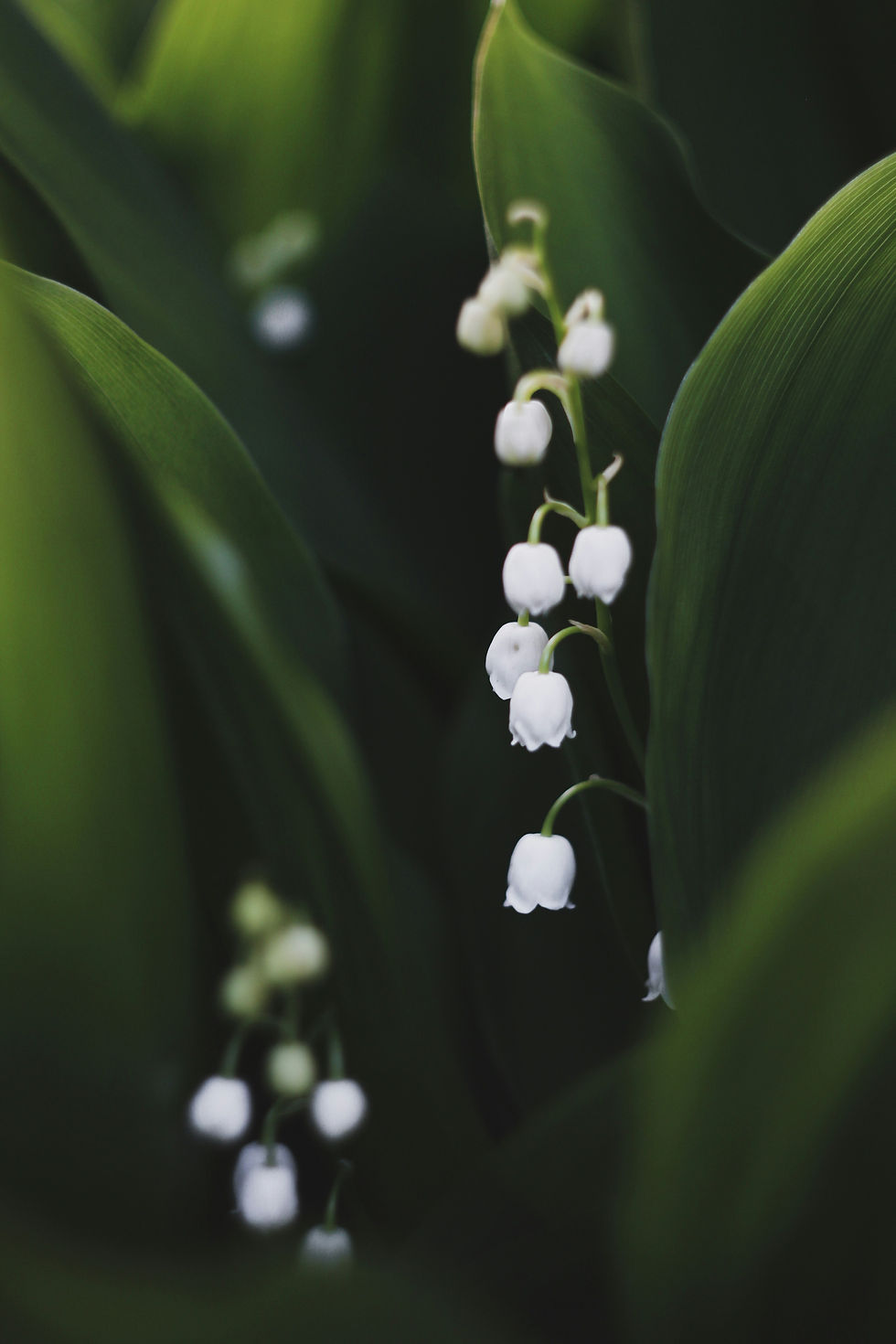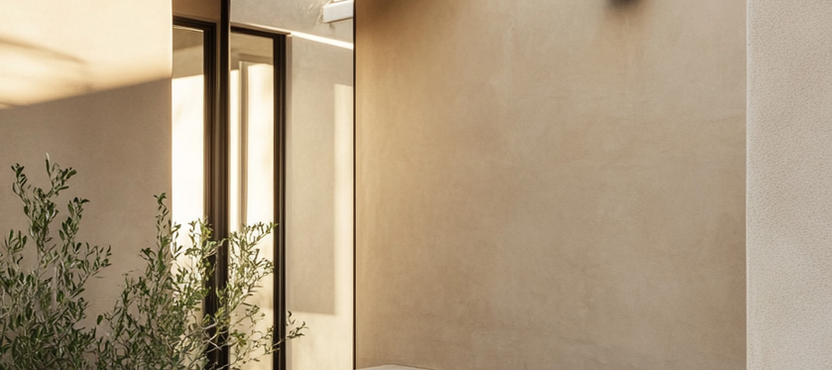Lily of the Valley: How to Grow, Style, and Protect This Enchanting Shade Bloom
- Beril Yilmaz

- May 18
- 4 min read
With their bell-shaped blossoms and enchanting scent, lily of the valley (Convallaria majalis) has earned its reputation as one of spring’s most adored flowers. Their graceful nodding heads peek out from under lush green foliage, making them an irresistible choice for shaded gardens, walkways, and woodland-inspired landscaping.
Though delicate in appearance, this perennial is surprisingly tough, spreading steadily via underground rhizomes to form a dense, sweet-scented carpet that requires little maintenance once established. A traditional harbinger of spring in many cultures, the lily of the valley is steeped in symbolism and has found its place not just in gardens, but in royal ceremonies, folklore, and even high fashion.
From how to grow lily of the valley, to exploring its deeper meaning, and understanding its hidden dangers—this guide has everything you need to know to appreciate and care for this charming bloom. Whether you're a seasoned gardener or a design enthusiast dreaming of a whimsical outdoor space, this post is your ultimate resource.
1. Lily of the Valley: Origins and Interesting Botanical Insights

Known botanically as Convallaria majalis, the lily of the valley belongs to the asparagus family (Asparagaceae)—a surprising fact considering its dainty appearance. It’s native to temperate regions across Europe and Asia and has been cultivated in gardens since at least the Middle Ages.
Despite its name, the plant is not a true lily. It thrives in cool, shaded areas and is admired for its delicate, white (and occasionally pale pink) blooms that appear in late spring. Each plant features arching stems with 5–15 pendulous flowers and wide, emerald-green leaves that remain attractive even after blooming.
One of the reasons gardeners cherish lily of the valley is its ability to naturalise quickly. Left undisturbed, a few plants can transform into an abundant floral ground cover over the years. However, due to its vigorous spread, it’s wise to plant it where it won’t outcompete more delicate companions.
2. Lily of the Valley: How to Grow and Care for This Flower in Your Garden

Ideal LocationLily of the valley prefers partial to full shade, making it perfect for planting under trees, beside north-facing walls, or in woodland-style borders. It thrives in moist, rich, well-draining soil enriched with organic matter like compost or leaf mould.
How to Plant
Buy "pips" (dormant root shoots) in early spring or autumn.
Soak the pips in lukewarm water for a few hours before planting.
Plant them 1-2 inches deep and 3-4 inches apart, with the tips just poking out of the soil.
Water generously after planting and keep the soil consistently moist until established.
Ongoing Care
Once settled, lily of the valley needs minimal attention. Apply mulch in late autumn to protect from frost and nourish the roots. In spring, water during dry spells and trim back spent foliage after blooming. They can be divided every 3-4 years to rejuvenate growth.
3. Lily of the Valley: Creative Ways to Use It in Landscaping

Want to make a statement with lily of the valley? Try these landscaping ideas:
Shade Path Edging: Use it to line shaded stone or gravel paths—its uniform height and lush texture create a soft border that transitions beautifully from spring to summer.
Tree Base Cover: Planted around the base of trees, it transforms forgotten corners into elegant woodland vignettes.
Container Gardens: Grow in decorative pots on shaded patios or balconies to enjoy their scent up close.
Moon Gardens: Pair with other white bloomers like white bleeding heart and hostas to create a nighttime-reflective moon garden.
4. Lily of the Valley: Beyond Beauty – Symbolism and Cultural Traditions

The flower’s pristine beauty has inspired legends and traditions for centuries. In Victorian floriography, lily of the valley symbolised “the return of happiness.” It’s no surprise that it remains a favourite in wedding bouquets, signifying purity and the promise of new beginnings.
In some European cultures, especially in France, it’s gifted on May 1st during “La Fête du Muguet” as a token of good luck. This custom dates back to Renaissance France, where it was offered as a lucky charm by King Charles IX.
The plant also carries spiritual weight. In folklore, it is said to have bloomed from the tears of the Virgin Mary or Eve’s sorrow when expelled from Eden—earning it names like “Our Lady’s Tears” and “Mary’s Tears.”
5. Lily of the Valley: Is It Dangerous?

Yes—lily of the valley is highly toxic. All parts of the plant contain cardiac glycosides, which affect the heart’s rhythm. Ingesting even a small amount can lead to symptoms like nausea, vomiting, dizziness, and in severe cases, heart arrhythmias.
Important Safety Tips:
Keep it out of reach of children and pets.
Wear gloves when handling large amounts of the plant.
Wash hands after gardening.
While it’s safe to admire and handle briefly, ingestion should be taken very seriously. Never use it in herbal remedies or as edible decor.
6. Lily of the Valley: Frequently Asked Questions (FAQs)

Q: Can I grow lily of the valley indoors?A: Yes! They grow well in containers in a cool, shady spot. Indoors, they need a bright but not sun-drenched location and moist, well-drained soil.
Q: Why isn't my lily of the valley blooming?A: If it’s not flowering, it may be due to too much sun, poor soil, or overcrowding. Try dividing and replanting in richer, more shaded soil.
Q: When is the best time to divide lily of the valley?A: Autumn is ideal. Lift and separate the rhizomes every 3–4 years for healthier, more vigorous growth.
Q: Will it grow back every year?A: Yes, it’s a perennial. Once established, it will return reliably each spring.
Elegant yet easy to grow, lily of the valley offers far more than just aesthetic value. It tells stories, anchors traditions, perfumes the air, and transforms shadowy spaces into serene sanctuaries. With its resilience and charm, it’s no wonder this bloom continues to capture hearts and gardens alike.
Whether you're planting for scent, symbolism, or sheer beauty, lily of the valley deserves a spot in your garden—and maybe, your heart.
Want to bring the tranquil beauty of lily of the valley into your garden or exterior living space? Let our award-winning team at BY Design And Viz help you create a breathtaking shade garden or woodland escape. We also offer architectural design solutions to integrate nature with lifestyle. From patios to full garden makeovers, we’ll design spaces that inspire peace, harmony, and beauty.
Get in touch today for a consultation and let your outdoor space bloom with elegance.


































